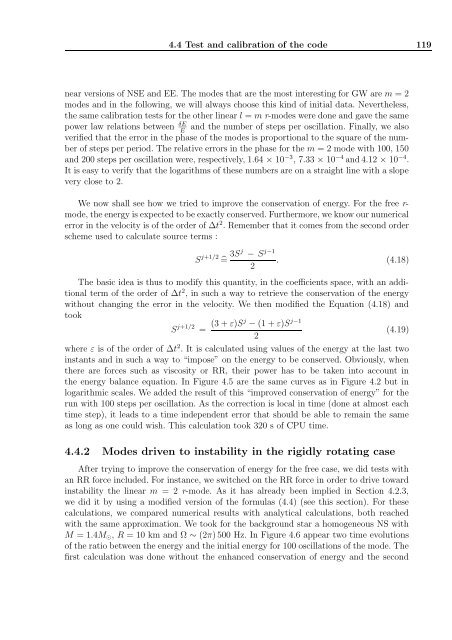Ecole doctorale de Physique de la région Parisienne (ED107)
Ecole doctorale de Physique de la région Parisienne (ED107)
Ecole doctorale de Physique de la région Parisienne (ED107)
Create successful ePaper yourself
Turn your PDF publications into a flip-book with our unique Google optimized e-Paper software.
4.4 Test and calibration of the co<strong>de</strong> 119<br />
near versions of NSE and EE. The mo<strong>de</strong>s that are the most interesting for GW are m = 2<br />
mo<strong>de</strong>s and in the following, we will always choose this kind of initial data. Nevertheless,<br />
the same calibration tests for the other linear l = m r-mo<strong>de</strong>s were done and gave the same<br />
power <strong>la</strong>w re<strong>la</strong>tions between δE and the number of steps per oscil<strong>la</strong>tion. Finally, we also<br />
E<br />
verified that the error in the phase of the mo<strong>de</strong>s is proportional to the square of the number<br />
of steps per period. The re<strong>la</strong>tive errors in the phase for the m = 2 mo<strong>de</strong> with 100, 150<br />
and 200 steps per oscil<strong>la</strong>tion were, respectively, 1.64 × 10−3 , 7.33 × 10−4 and 4.12 × 10−4 .<br />
It is easy to verify that the logarithms of these numbers are on a straight line with a slope<br />
very close to 2.<br />
We now shall see how we tried to improve the conservation of energy. For the free rmo<strong>de</strong>,<br />
the energy is expected to be exactly conserved. Furthermore, we know our numerical<br />
error in the velocity is of the or<strong>de</strong>r of ∆t 2 . Remember that it comes from the second or<strong>de</strong>r<br />
scheme used to calcu<strong>la</strong>te source terms :<br />
S j+1/2 = 3Sj − Sj−1 . (4.18)<br />
2<br />
The basic i<strong>de</strong>a is thus to modify this quantity, in the coefficients space, with an additional<br />
term of the or<strong>de</strong>r of ∆t 2 , in such a way to retrieve the conservation of the energy<br />
without changing the error in the velocity. We then modified the Equation (4.18) and<br />
took<br />
S j+1/2 = (3 + ε)Sj − (1 + ε)S j−1<br />
2<br />
(4.19)<br />
where ε is of the or<strong>de</strong>r of ∆t 2 . It is calcu<strong>la</strong>ted using values of the energy at the <strong>la</strong>st two<br />
instants and in such a way to “impose” on the energy to be conserved. Obviously, when<br />
there are forces such as viscosity or RR, their power has to be taken into account in<br />
the energy ba<strong>la</strong>nce equation. In Figure 4.5 are the same curves as in Figure 4.2 but in<br />
logarithmic scales. We ad<strong>de</strong>d the result of this “improved conservation of energy” for the<br />
run with 100 steps per oscil<strong>la</strong>tion. As the correction is local in time (done at almost each<br />
time step), it leads to a time in<strong>de</strong>pen<strong>de</strong>nt error that should be able to remain the same<br />
as long as one could wish. This calcu<strong>la</strong>tion took 320 s of CPU time.<br />
4.4.2 Mo<strong>de</strong>s driven to instability in the rigidly rotating case<br />
After trying to improve the conservation of energy for the free case, we did tests with<br />
an RR force inclu<strong>de</strong>d. For instance, we switched on the RR force in or<strong>de</strong>r to drive toward<br />
instability the linear m = 2 r-mo<strong>de</strong>. As it has already been implied in Section 4.2.3,<br />
we did it by using a modified version of the formu<strong>la</strong>s (4.4) (see this section). For these<br />
calcu<strong>la</strong>tions, we compared numerical results with analytical calcu<strong>la</strong>tions, both reached<br />
with the same approximation. We took for the background star a homogeneous NS with<br />
M = 1.4M⊙, R = 10 km and Ω ∼ (2π) 500 Hz. In Figure 4.6 appear two time evolutions<br />
of the ratio between the energy and the initial energy for 100 oscil<strong>la</strong>tions of the mo<strong>de</strong>. The<br />
first calcu<strong>la</strong>tion was done without the enhanced conservation of energy and the second
















